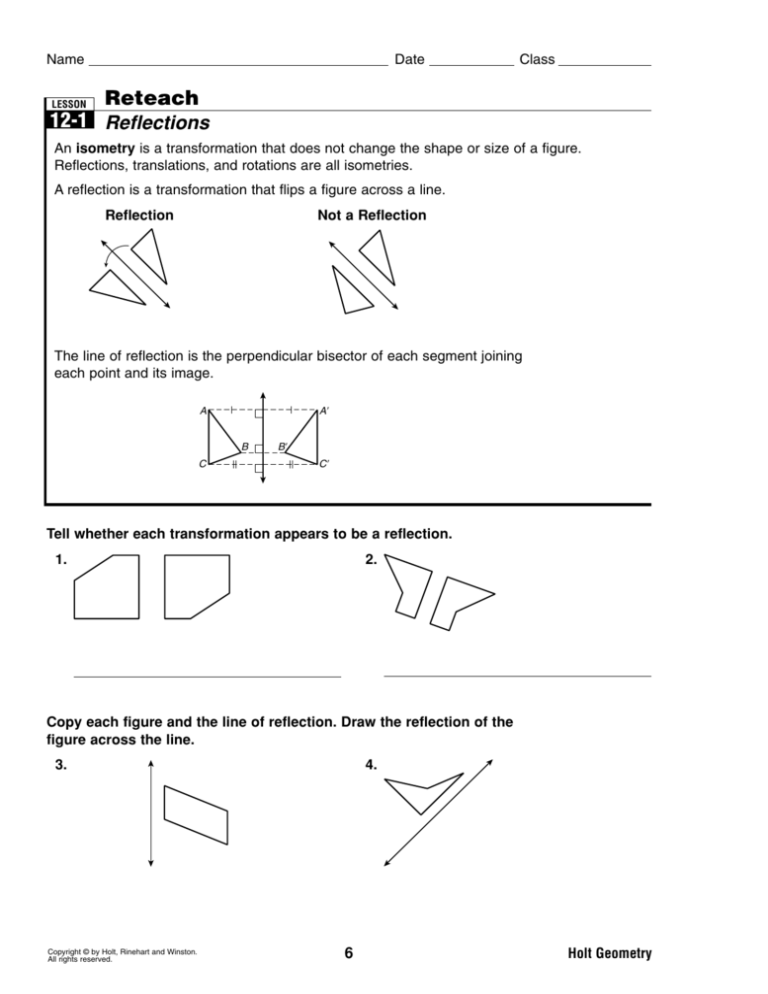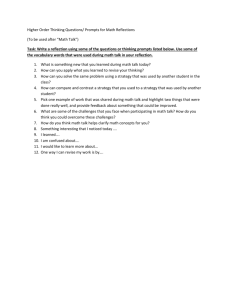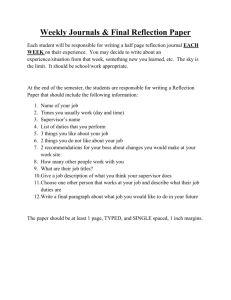
Name
LESSON
Date
Class
Reteach
12-1 Reflections
An isometry is a transformation that does not change the shape or size of a figure.
Reflections, translations, and rotations are all isometries.
A reflection is a transformation that flips a figure across a line.
Reflection
Not a Reflection
The line of reflection is the perpendicular bisector of each segment joining
each point and its image.
!
!
"
#
"
#
Tell whether each transformation appears to be a reflection.
2.
1.
yes
no
Copy each figure and the line of reflection. Draw the reflection of the
figure across the line.
4.
3.
Copyright © by Holt, Rinehart and Winston.
All rights reserved.
6
Holt Geometry
Name
LESSON
Date
Class
Reteach
12-1 Reflections continued
Reflections in the Coordinate Plane
Across the x-axis
Across the y -axis
Across the line y x
Y
Y
Y
2 (X, Y)
2 (X, Y)
2 (X, Y)
2 (X, Y)
2 (Y, X)
X
X
0
X
0
0
2 (X, Y)
YX
(x, y ) → (x, y)
(x, y) → (x, y )
(x, y) → ( y, x)
Reflect 䉭FGH with vertices F(1, 4), G (2, 4), and H (4, 1)
across the x-axis.
The reflection of (x, y) is (x, y).
F(1, 4) → F(1, 4)
G(2, 4) → G(2, 4)
H(4, 1) → H (4, 1)
Graph the preimage and image.
Y
&
'
2
(
X
0
2
2
(
2
'
&
Reflect the figure with the given vertices across the line.
5. M (2, 4), N(4, 2), P(3, 2); y -axis
6. T(4, 1), U(3, 4), V(2, 3), W(0, 1); x -axis
Y
Y
X
X
7. Q (3, 1), R(2, 4), S(2, 1); x-axis
8. A (2, 4), B(1, 1), C(5, 1); y x
Y
Y
X
X
Copyright © by Holt, Rinehart and Winston.
All rights reserved.
7
Holt Geometry
Name
Date
Class
Name
Date
Class
Practice A
LESSON
12-1 Reflections
Practice B
LESSON
12-1 Reflections
Fill in the blanks to complete each definition.
Tell whether each transformation appears to be a reflection.
1. A reflection is a transformation across a line, called the line of reflection, so that
the line of reflection is the perpendicular bisector of each segment joining
each point and its image.
isometry
2. An
shape or size of a figure.
is a transformation that does not change the
yes
2.
no
3.
yes
4.
no
Draw the reflection of each figure across the line.
Tell whether each transformation appears to be a reflection.
3.
no
4.
yes
5.
yes
6.
no
6.
5.
7. Sam is about to dive into a still pool, but some sunlight is
reflected off the surface of the water into his eyes. On the
figure, plot the exact point on the water’s surface where the
sunlight is reflected at Sam.
Draw the reflection of each figure across the line. To do this, draw a dashed segment
from each vertex perpendicular to the line. Use a ruler to make the dashed segments
on either side of the line have equal length.
8. A (4, 4), B (3, �1), C (1, �2); y-axis
��
9. Renata and Owen stand in front of a mirror at the positions shown in
the figure. Owen looks into the mirror so he can see Renata in the
mirror. Plot the reflection of Renata’s position and label it R �. Label
with an X the point on the mirror where Owen should look in order
to see Renata.
��
�
��
��������
��
��
�������
� ��������
���������
� ��������
��
��������
3
Copyright © by Holt, Rinehart and Winston.
All rights reserved.
Name
Date
�
10. P(1, 3), Q(�2, 3), R(�2, 1), S(1, 0);
x-axis
�
��
��
�
11. J (3, �4), K (1, �1), L (�1, �1),
M(�2, �4); y � x
�
�
�
�
�����
��
�
�
�
��
��
�
�
��
��
�
�
��
�
���
�
�
��
�
��
��
�
��
��
��
��
�
�
�
Class
Holt Geometry
4
Copyright © by Holt, Rinehart and Winston.
All rights reserved.
Name
Practice C
LESSON
12-1 Reflections
Date
Class
Holt Geometry
Reteach
LESSON
12-1 Reflections
Write paragraph proofs for Exercises 1 and 2.
_
1. Given: B� is the reflection of B across line �. C is on AB � .
Prove: AC � BC is the shortest distance from A to line �
and then to B.
(Hint: Use the Triangle Inequality
Theorem.)
_
�
An isometry is a transformation that does not change the shape or size of a figure.
Reflections, translations, and rotations are all isometries.
�
�
��
A reflection is a transformation that flips a figure across a line.
�
Reflection
_
Possible answer: Draw BB� . Label point D at the intersection of BB� and
line �. It is given that B� is
the reflection
of
B across line �. Therefore � is the
_
_
_
perpendicular
of BB � . So BD � B�D, and �BDC and �B�DC are right
_ bisector
_
angles. CD
CD by the reflexive property, so �BDC � �B�DC by SAS. By
_� _
CPCTC, BC � B�C, and therefore AC � BC �
AC � B�C. Note that �BDC �
_
�B�DC regardless of whether point C is on AB_
�, and so AC � BC is always
equal to AC � B�C. Suppose that C is not on AB �. Then �AB�C exists. The
Triangle Inequality Theorem states that the sum of the lengths of two sides of
a triangle is greater than the length of the third side. Therefore AC � B�C is
at a minimum when the three points are collinear, and
_thus AC � BC is the
�
shortest distance from A to line � to‹___
B› when C_
is on AB �.
�
2. Given: R� is the reflection of R across PQ. T is on SR� .
Prove: �RTP � �STQ
_
�
�
Possible
Draw RR �. Label point U at the intersection ‹__› ��
_ answer:
‹__›
of RR� andPQ.
It is given that R� is the reflection
PQ.
_of R across
_ _
‹__›
Therefore PQ is the perpendicular bisector
of RR �. So RU � R �U, and
_ _
�RUT and �R�UT are right angles. UT � UT by the reflexive property,
so �RUT � �R�UT by SAS. By CPCTC, �RTU � �R�TU. �R�TU is also
congruent to �STQ because they are vertical angles. By the transitive
property, �RTP � �STQ.
�
5
Copyright © by Holt, Rinehart and Winston.
All rights reserved.
��
�
�
��
��
��
Tell whether each transformation appears to be a reflection.
2.
1.
yes
no
Possible answer: The distance from F (2a, 2b) to y � x is the distance along
a perpendicular to that line. The slope of the perpendicular is �1, and the
y-intercept is 2a � 2b. The equation of the line through F perpendicular to
y � x is y � �x � 2a � 2b. Setting the equations of the lines equal shows
that they intersect at G(a � b, a � b). The distance formula shows that
�
�
FG � � 2 (a � b). The distance formula also shows that F �G � � 2 (a � b). So
part (1) is proven. Substituting the x-coordinate of F�, 2b, into the equation of
the perpendicular returns the y-coordinate of F�, 2a. Therefore F�(2b, 2a) is
on the perpendicular line through FG, and part (2) is proven.
4. A point with coordinates (x, y ) is reflected across y � �x.
Find the coordinates of the image.
Not a Reflection
The line of reflection is the perpendicular bisector of each segment joining
each point and its image.
3. Prove that the reflection of F(2a, 2b) across y � x is F�(2b, 2a) by showing two things:
(1) that the distance from ‹__
F ›to a point G on y � x is equal to the distance from F� to
G and (2) that F� lies on FG.
Copyright © by Holt, Rinehart and Winston.
All rights reserved.
�
�
��
��
�
��
�
��
�
��
�
�
��
�
�� �
�
�
�����
�
�
��
Owen
�
�
�
��
�
Renata
�
� ��������
�
��
�
�
�
�
11. P(2, 3), Q(4, 0), R(1, �4), S(0, �2); y-axis
�
�
���
�����
9. D(�4, �1), E (�2, 3), F (�1, 1); y � x
�
�
mirror
Reflect the figure with the given vertices across the given line. Plot and label the
vertices of the image one at a time. Remember that for reflections across the
x-axis, (x, y) � (x, �y ), and for reflections across the y-axis, (x, y ) � (�x, y ).
10. A(�2, 2), B (3, 3), C (2, 1); x-axis
���
Reflect the figure with the given vertices across the given line.
8.
7.
1.
Copy each figure and the line of reflection. Draw the reflection of the
figure across the line.
4.
3.
(�y, �x)
Holt Geometry
Copyright © by Holt, Rinehart and Winston.
All rights reserved.
59
6
Holt Geometry
Holt Geometry
Name
Date
Class
Name
Reteach
LESSON
12-1 Reflections continued
Across the y -axis
Across the line y � x
�
�
� �(��, �)
� ( �, � )
� (�, �)
�
� �(�, ��)
(x, y) � (x, �y )
(x, y) � (�x, y )
�
�
�
y�1
2
Using a separate sheet of graph paper, repeat parts a and b of Exercise 1
for each transformation. Check student’s graphs.
�
�
0
2
��
�2
2. Q (x, y ) � (x, �y � 6)
a.
��
��
�
��
��
�
�
��
�
��
�
�
��
�
�
��
��
�
�
�
�
��
�
�����
�
�
�
�
�
�
��
�
��
��
8. Two other lines that are often used as lines of reflection are y � x
and y � �x. They are graphed on the coordinate plane at right.
Investigate several reflections across these lines. Then write a
rule for each reflection.
�
�
��
��
a. reflection across y � x:
7
Copyright © by Holt, Rinehart and Winston.
All rights reserved.
Name
Date
Class
Holt Geometry
F(x, y) �
Problem Solving
LESSON
12-1 Reflections
2. In the drawing, the left side of a structure
is shown with its line of reflection. Draw
the right side of the structure.
Date
Holt Geometry
Class
Use the concept map below to help you understand reflections.
Definition
A reflection is a transformation that moves a figure, called the preimage,
by flipping it across a line. The reflected figure is called the image.
(�3, 5)
3. The function y � �3x passes through
the point P(6, �729). If the graph is
reflected across the y-axis, what are the
coordinates of the image of P?
Reflections
Examples
Reflections in the
Coordinate Plane
Reflections can be made
(�6, �729)
• across the x-axis
(x, y)
(x, �y)
• across the y-axis
(x, y)
(�x, y)
Choose the best answer.
4. A park planner is designing two paths
that connect picnic areas E and F to a
point on the park road. Which point on the
park road will make the total length of the
paths as small as possible? (Hint: Use a
reflection. What is the shortest distance
between two points?)
• across the line y � x
(x, y)
(y, x)
5. �RST is reflected across a line so that
T � has coordinates (1, 3). What are the
coordinates of S�?
Tell whether each transformation appears to be a reflection.
�
�
2.
1.
3.
�
�
�
��
�
�
�
Reading Strategies
LESSON
12-1 Use a Concept Map
1. Quadrilateral JLKM has vertices J (7, 9),
K(0, �4), L (2, 2), and M(5, �3). If the
figure is reflected across the line y � x,
what are the coordinates of M�?
����
����
��
�
(�y, �x)
8
Copyright © by Holt, Rinehart and Winston.
All rights reserved.
Name
��
(y, x)
b. reflection across y � �x: G(x, y ) �
��
�
��
��
��
��
(x, �y � 2k)
K(x, y) �
7. Recall that the equation of any vertical line can be written in the form x � j, where j
is a constant. Based on your work in Exercises 1–6, make a conjecture about a
rule for reflecting a point across a vertical line. Verify your conjecture
by testing several specific cases.
J (x, y) �
(�x � 2j, y)
8. A (�2, 4), B (1, 1), C(�5, �1); y � x
�
y � �3
b.
the transformation for reflection across the x-axis.
��
��
7. Q(�3, �1), R (2, 4), S (2, 1); x-axis
y � �2
b.
A�(4, �7), B�(5,�4),
C�(�6, �6)
the line y � k, K(x, y) � (x, �y � 2(0)) � (x, �y ). This is the same as
��
�
a.
C�(�6, �4)
An equation of the x-axis is y � 0. So, using the rule for reflection across
�
�
��
4. T (x, y) � (x, �y � (�6))
A�(4, �5), B�(5, �2),
6. Explain how you can apply your rule from Exercise 5 to a reflection across the x-axis.
�
�
��
a.
5. Write a rule for reflecting a point across any
line y � k, where k is a constant.
�
�
�
��
3. S(x, y ) � (x, �y � (�4))
y�3
b.
6. T(�4, 1), U(�3, 4), V(2, 3), W(0, 1); x -axis
�
�
A�(4, 5), B�(5, 8),
C�(�6, 6)
Reflect the figure with the given vertices across the line.
5. M (2, 4), N (4, 2), P(3, �2); y -axis
�
� �������
b. Draw the line of reflection. Then write an equation for it.
Recall that the equation of any horizontal line can be
written in the form y � k, where k is a constant.
(x, y ) � (y, x)
�2
�
� �������
A�(4, 1), B �(5, 4), C�(�6, 2)
���
Reflect �FGH with vertices F(�1, 4), G (2, 4), and H (4, 1)
across the x-axis.
The reflection of (x, y) is (x, �y).
F(�1, 4) � F �(�1, �4)
G (2, 4) � G�(2, �4)
H (4, 1) � H �(4, �1)
Graph the preimage and image.
��
� ������
a. Draw the image of �ABC under this transformation.
Write the coordinates of A�, B�, and C�.
�
0
��
�����
��
1. Use the figure at right and P (x, y) � (x, �y � 2).
� �(�, �)
�
0
0
�
There are infinitely many lines in a coordinate plane, and
you can reflect a point across any of them. The relationships
between the coordinates of the preimage and image points
can give rise to some interesting patterns.
�
�
� (�, � )
Class
Challenge
LESSON
12-1 Other Reflections on the Coordinate Plane
Reflections in the Coordinate Plane
Across the x-axis
Date
�
�
A W
C Y
B X
D Z
�
�
no
�
��
�
yes
Give the vertices of the image after it is reflected across the given line.
F (0, 2)
G (0, �2)
A�(2, �1), B �(6, �1),
4. A(2, 1), B(6, 1), C(4, 3) across the x-axis
H (2, 0)
J (�2, 0)
C�(4, �3)
5. N(1, 2), P(3, 5), Q(3, 7), R(1, 6) across the line y � x
6. �MNP with vertices M(1, 5), N (0, �3),
and P(�2, 2) is reflected across a line.
The coordinates of the reflection image
are M�(7, 5), N�(8, �3), and P�(10, 2).
Over which line was �MNP reflected?
A y�2
7. Sarah is using a coordinate plane to
design a rug. The rug is to have a triangle
with vertices at (8, 13), (2, �13), and
(14, �13). She wants the rug to have a
second triangle that is the reflection of the
first triangle across the x-axis. Which is a
vertex of the second triangle?
B x�2
C y�4
F (�13, 14)
G (�14, 13)
D x�4
Copyright © by Holt, Rinehart and Winston.
All rights reserved.
yes
�
9
Copyright © by Holt, Rinehart and Winston.
All rights reserved.
N�(2, 1), P�(5, 3), Q�(7, 3),
R�(6, 1)
Draw the reflection of each figure across the line.
6.
7.
8.
H (�2, �13)
J (2, 13)
Holt Geometry
Copyright © by Holt, Rinehart and Winston.
All rights reserved.
60
10
Holt Geometry
Holt Geometry







